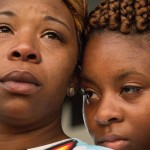Top 5 Live-WURD Monday August 10
1. Supporters pay tribute to Michael Brown
Hundreds of people gathered Sunday morning at the memorial of Michael Brown, an unarmed black teen who was shot dead in the middle of the street by a white police officer exactly one year ago.
Teddy bears and candles now mark the memorial on Canfield Drive where the community’s outrage to Brown’s death planted the seeds of protests that would grow into a national movement decrying police violence
Michael Brown Sr. led the crowd to pause in silence at 11:55 central – the exact time the unarmed teen was shot and killed. He stood in silence for four and a half minutes, representing each hour his son’s body was left in the street.
“Just wanted to give all my love to my family, friends, my people, my new friends, my world,” he said.
Elenore Humphrey, a student in St. Louis, described the gathering as a powerful and solemn moment, the air still thick with raw emotion.
“It’s loss. It’s remorse. But it’s also anger. All of the emotions you don’t want to have,” she said. “All of the emotions that a lot of people have the privilege to ignore.”
2. Lawsuit alleges Bobbi Kristina Brown’s boyfriend gave her ‘toxic cocktail’
The estate of Bobbi Kristina Brown has filed a multimillion-dollar wrongful death lawsuit against her boyfriend, alleging he is responsible for the injuries that led to her death last month.
The lawsuit filed Friday alleges Nick Gordon, who shared a townhome with Brown in the Atlanta suburb of Roswell, beat her after an argument on the morning of January 31, then gave her a “toxic cocktail” to knock her out.
It accuses him of placing her face-down in a bathtub of cold water, causing her to suffer brain damage.
The suit seeks at least $10 million.
Brown, the only child of the late Whitney Houston and singer Bobby Brown, was rushed to the hospital after the incident in January and placed in a medically induced coma. She died in hospice care late last month at age 22.
3. Sanders’ biggest rally yet comes with an undercurrent of racial issues
Bernie Sanders came to Seattle on Saturday with plans to give two speeches.
The first didn’t happen. An appearance by the Vermont senator at an event celebrating the anniversary of Social Security and Medicare was scuttled after protesters from a local Black Lives Matter chapter took over the stage.
The protesters took the microphone and demanded that the crowd hold Sanders “accountable” for not doing enough to address police brutality and other issues.
After sharing grievances with the crowd, including school disparities and gentrification in Seattle, the protesters asked for a period of silence to commemorate the one-year anniversary of Michael Brown being shot and killed by a Ferguson, Mo., police officer.
Hours later, Sanders drew about 15,000 at a basketball arena.
4. Kane’s career and freedom in jeopardy
On Thursday, Kathleen Kane, the state’s highest-ranking law enforcement official, was charged with illegally leaking confidential information, lying about it under oath, and deploying aides to spy on people involved in the investigation.
Kane was charged with perjury, obstruction, conspiracy, official oppression, and other offenses.
On Saturday, Kane was fingerprinted at the Montgomery County detective bureau in Norristown and arraigned via video conference by Magisterial Judge Cathleen Kelly Rebar, who set bail at $10,000 unsecured, which allowed Kane to depart.
In outlining the case against Kane, Montgomery County District Attorney Risa Vetri Ferman portrayed her as reckless in the extreme in her desire to get even with Fina, once the office’s star prosecutor.
Kane’s war, Ferman said, was “conducted without regard to rules, without regard to the law, and without regard to collateral damage the battle might entail.”
To her critics, including many former aides, Kane is a woman who grew intoxicated by her big election victory and a year’s worth of praise, and then crumpled at the first burst of bad publicity.
5. A Year After Ferguson, Housing Segregation Defies Tools to Erase It
A year after the fatal shooting of Michael Brown, an unarmed black 18-year-old, by Darren Wilson, a white police officer, unleashed a torrent of unrest in Ferguson, the St. Louis region has been embroiled in a difficult discussion about race and class — and not just regarding the police.
Questions about whether minorities have access to good jobs, high-performing schools and low-crime neighborhoods have been fiercely debated. And for many, one question informs all those others: Can the barriers that keep blacks out of prosperous, mostly white communities be toppled?
Data suggests that they often cannot. By several measures, the St. Louis region remains among the most segregated places in the country.
Such is the case in Ferguson. The part where Mr. Brown died is a predominantly black east side neighborhood where residents have complained of police harassment and high crime in a cluster of apartments that stretches into the census tract with the most Section 8 renters in Missouri. Just two miles away pockets of predominantly white, affluent neighborhoods with sturdy brick and clapboard homes surround the city’s amenity-filled central business district.
Click here to read these stories on 900amWURD.

Solomon Jones is an Essence bestselling author and award-winning columnist. He is the creator and editor of Solomonjones.com and morning host on 900 am WURD radio. Click here to learn more about Solomon




